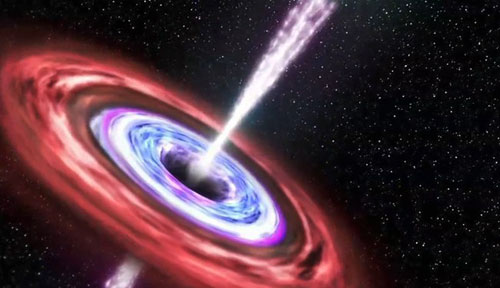|

by Douglas Cobb
November 30, 2013.
from
GuardianLibertyVoice Website

When a recently-discovered black hole was discovered which emits
brilliant light, scientists were baffled, and scrambled to explain
how a black hole could shine with such brilliance.
According to a
new study, the black-hole system called
ULX-1 in the nearby Pinwheel
Galaxy is twice as bright as astronomers had believed one could ever
be.
The
Pinwheel Galaxy (or M101) is 22 million light-years from Earth.
The amazing brightness of the black hole there might force
astronomers to rethink theories about black holes and how they
radiate energy.
According to the studyís coauthor, Joel Bregman of the University of
Michigan, the black hole,
"is an extremely luminous one that
is shining as brightly as it possibly can."
The black-hole system in the Pinwheel Galaxy is made up of a star
and a black hole which orbit each other. ULX stands for
"ultraluminous X-ray source."
The black hole generates a massive
amount of extremely bright x-ray light. The light comes from
material that the black hole is consuming, as it spirals down into
its depths.
The black hole is behaving somewhat like an intermediate black hole,
but intermediate black holes are between 100-1,000 times the mass of
the sun.
However, the new study, which appears in the journal
Nature (Puzzling
Accretion onto a Black Hole in the Ultraluminous X-ray Source M-101
ULX-1), suggests that the black hole is just 20 times the mass of
the sun. This mass would put it on rather the small side for a black
hole, yet it consumes matter at the rate a larger one would.
Jifeng Lui of the Chinese Academy of Sciences in Beijing led the
research team which studied ULX-1.
They used,
By knowing through spectroscopic analysis using the
Gemini
Multi-Object Spectrograph in Hawaii that the companion star in the
ULX-1 black hole system is a large, hot type of star known as a
Wolf-Rayet, the research team was able to infer the mass of the star
from its luminosity.
They inferred that it was 19 times the sunís
mass.
Lui and his team learned that the black hole and the
Wolf-Rayet star
orbited each other every 8.2 days. This fact enabled the research
team to estimate that the mass of the black hole was somewhere
between 20-30 times the sunís mass.
The low mass of the black hole caused Lui and the other researchers
to theorize that the black hole was a stellar one. Stellar black
holes form after a star dies and collapses in upon itself. A
middleweight black hole has yet to be definitely discovered, though
itís theorized that they exist at the heart of most - and possibly
all - galaxies.
Ultraluminous X-ray sources have often been taken to be evidence of
intermediate-sized black holes, but Lui said in a statement that
their findings might "turn the trend" of this assumption by many
astronomers occurring so much in the future.
How is the black hole in ULX-1 system emitting so much light?
Lui and his research team theorize that the black hole is emitting
light from
the stellar wind (stream of charged particles) that itís
consuming from its companion star.
In concluding that the black hole in the ULX-1 system is a stellar
one, Lui and his team has demonstrated that,
"our understanding of the black hole
radiation mechanism is incomplete and needs revision."
According to another member of the research team,
Stephen Justham - also of the National Astronomical Observatories of China
- low mass
black holes like the one in the ULX-1 system must consume energy at
close to the theoretical limits that are possible in order for it to
release as much energy as has been detected.
Theoretical models of how matter falls into and is consumed by black
holes which radiate forth energy show that
soft X-rays come mostly
from whatís known the,
"accretion disk a disk which encircles the
black hole."
Hard X-rays, on the other hand, are emitted by a
high-energy corona which is around the disk.
One of the many puzzling aspects about ULX-1 is that, based upon the
size of the black hole, that the region around it should be marked
by hard X-rays and be more complex in its structure - but, that
isnít the case with the black hole in the ULX-1 system.
According to Jifeng Lui, current theories donít adequately explain
how the black hole in the ULX-1 system is behaving.
Mechanisms
mentioned in these theories that,
"allow such low-mass black holes to
eat this quickly and shine this brightly" also "leave signatures in
the emitted X-ray spectrum."
But, these sorts of signatures arenít
displayed by the black hole in ULX-1.
The studyís coauthor, Paul Crowther of the University of Sheffield in
the UK, said that as it takes so long for us to get light and images
from a galaxy as far away as the Pinwheel Galaxy, the Wolf-Rayet
star is also probably dead,
"so this system is now likely a
double black hole binary."
|

